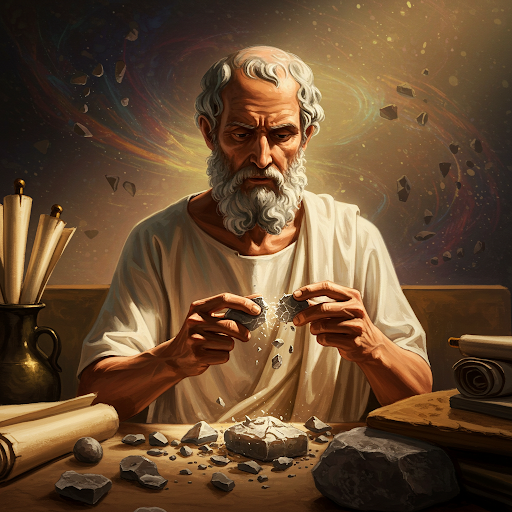The Void and the Atom: Unseen Worlds, Undivided Truths.
370 BCE, Abdera. A dusty, sun-baked workshop, where the unseen building blocks of reality are first imagined.
A stark, abstract illustration of swirling, geometric shapes representing atoms, interspersed with vast, dark spaces. A single, weathered stone tablet rests in the foreground.
The air is thick with the scent of dried herbs and sun-warmed stone. A rough-hewn table is covered with fragments of rock, each meticulously examined.
Democritus, his eyes intense and searching, gestures towards a collection of tiny, geometrically shaped stones. “Observe,” he rasps, his voice like the rustle of dry leaves, “the indivisible. The atom. The very essence of all that is.” He picks up two stones, one larger than the other. “The more it exceeds, the heavier it is,” he declares, weighing them in his hands.
You notice a series of drawings etched into a wax tablet, depicting various shapes and arrangements of these “atoms,” interspersed with empty spaces. “The void,” Democritus whispers, pointing to the spaces between the stones, “the unseen canvas upon which reality is painted.” A faint, almost imperceptible hum emanates from the stones, and you hear Democritus mutter, “Shape dictates substance. The unseen shapes create the seen world.” A fragment of papyrus lies nearby, bearing the inscription: “Seek the harmony of shapes, the weight of the indivisible, and the emptiness between.”

All matter is composed of indivisible atoms, moving within an empty void.
A faint shimmer emanates from a collection of polished stones: “Follow the shapes to uncover the secrets of material form. A dark, echoing passage opens, hinting at the vastness of the void: “Explore the emptiness to understand the true nature of space. A weathered scroll displays a series of geometric patterns: “Decipher the shapes to unlock the laws of formalized logic with Aristotle.
